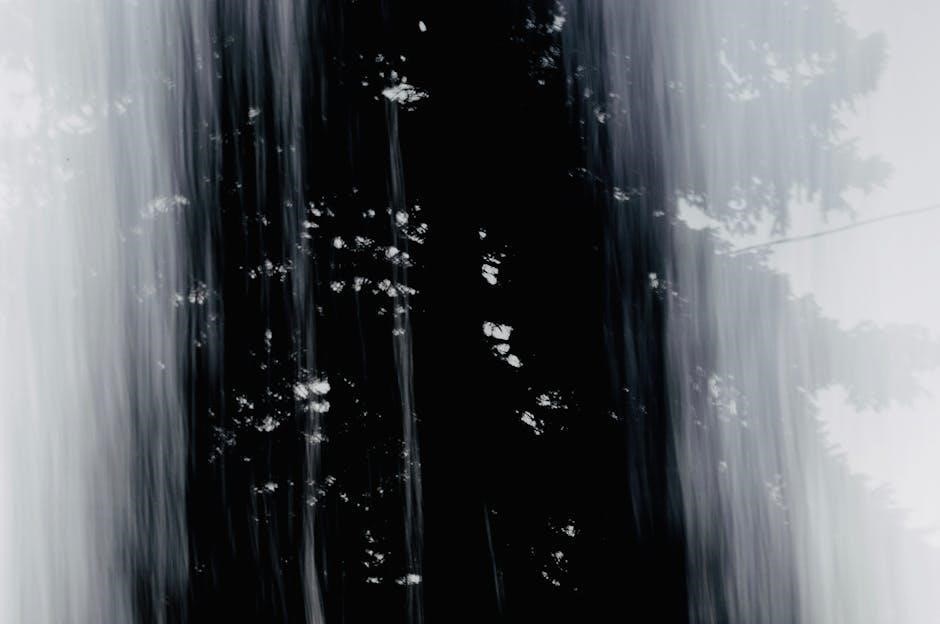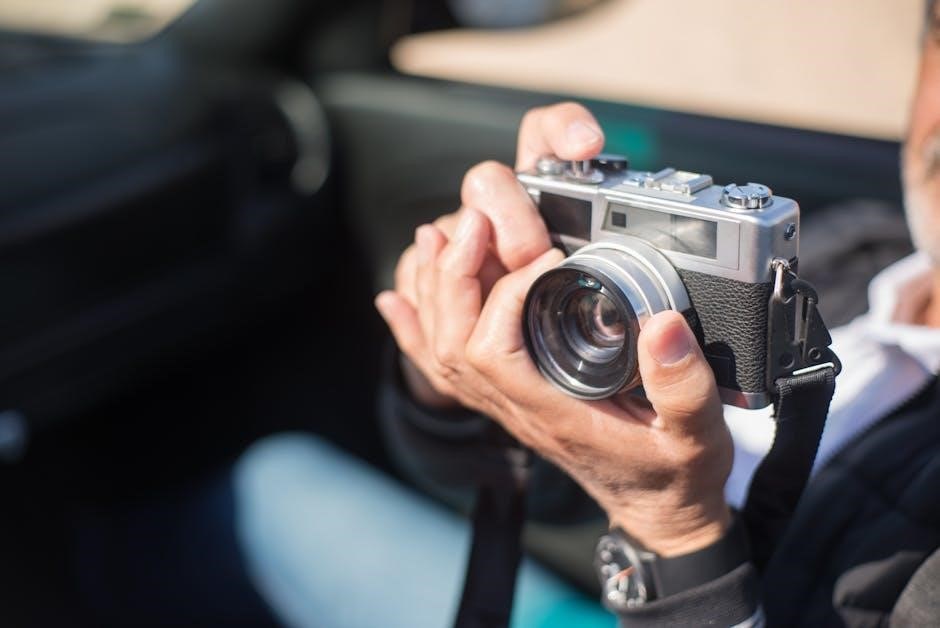
This manual introduces the Nikon D5000, a 12.3MP DSLR with EXPEED processing, offering HD video and ISO 100-6400. It guides users through features, settings, and troubleshooting;
1.1 Overview of the Nikon D5000
The Nikon D5000 is a 12.3-megapixel DSLR camera designed for enthusiasts and professionals. It features a CMOS sensor, EXPEED image processing, and HD video recording. With a compact and lightweight design, it offers a 2.7-inch vari-angle LCD screen for flexible shooting. The camera supports ISO sensitivity from 100 to 6400, ensuring low noise in various lighting conditions. It also includes Scene Modes and Live View functionality, making it versatile for different photography needs. This overview highlights its key features and capabilities for capturing high-quality images and videos.
1.2 Key Features of the Nikon D5000
The Nikon D5000 features a 12.3MP CMOS sensor, EXPEED image processing, and a 2.7-inch vari-angle LCD for flexible shooting. It supports HD video recording and Live View for precise framing. The camera offers an ISO range of 100-6400, reducing noise in low-light conditions. With Scene Modes for specific shooting scenarios and a burst mode of up to 4 fps, it caters to diverse photography needs. Its 11-point autofocus system ensures sharp images, while the lightweight design enhances portability and usability for enthusiasts and professionals alike.

Understanding the Camera Components
Explore the Nikon D5000’s DSLR design, including its CMOS sensor, vari-angle LCD, and F-mount lens compatibility. Learn about its key components and their functions for optimal use.
2.1 Camera Layout and Controls
The Nikon D5000 features an intuitive layout with a mode dial, AF switch, and Live View button. The vari-angle LCD screen offers flexible composition. Key controls include the shutter release, aperture/exposure compensation button, and command dial. The camera’s ergonomic design ensures comfortable handling. Familiarize yourself with the lens mount, focus ring, and VR switch for optimal functionality. This section helps users navigate the camera’s exterior components efficiently, ensuring smooth operation during photography sessions.
2.2 Lens and Accessories Compatibility
The Nikon D5000 is compatible with Nikon F-mount lenses, including AF-S and AF-I types, ensuring versatile shooting options. It supports a wide range of accessories like Speedlights and remote controllers. The camera also works with optional GPS units for geotagging and wireless transmitters for image transfer. This compatibility allows users to enhance their photography experience with a variety of tools tailored to their needs, ensuring optimal performance and creativity.
Camera Modes and Shooting Options
Explore the Nikon D5000’s versatile modes, including AUTO for simplicity, P/S/A/M for creative control, and Scene Modes for tailored settings in various photography situations.
3.1 AUTO Mode for Beginners
The AUTO Mode on the Nikon D5000 simplifies photography for beginners by automatically adjusting exposure, ISO, and focus. It’s ideal for casual shooting, delivering well-balanced results without manual adjustments. The camera handles all settings, allowing users to focus on composition and capturing moments. This mode is perfect for new photographers learning the basics or for quick shots in everyday situations. It ensures great image quality with minimal effort, making it a reliable starting point for understanding the camera’s capabilities.
3.2 P/S/A/M Modes for Advanced Users
The Nikon D5000 offers P/S/A/M modes for advanced photographers, providing precise control over settings. Program (P) mode adjusts aperture and shutter speed automatically but allows customization. Shutter Priority (S) mode lets users set shutter speed to freeze or blur motion. Aperture Priority (A) mode enables control over aperture for depth of field. Manual (M) mode offers full control over both aperture and shutter speed. These modes cater to experienced users seeking creative control and customization for specific shooting scenarios.
3.3 Scene Modes for Specific Situations
The Nikon D5000 features Scene Modes tailored for specific shooting scenarios, offering automatic optimization for various conditions. Common modes include Portrait, Landscape, Night Portrait, and Action, each adjusting settings like aperture, shutter speed, and ISO for ideal results. These modes simplify photography for users, ensuring vibrant colors and sharp focus in situations like low light, fast motion, or scenic vistas. They provide a practical solution for capturing stunning images without manual adjustments, catering to both casual and aspiring photographers.

Settings and Customization
This section explores the Nikon D5000’s menu system, allowing users to customize settings such as autofocus, metering, and noise reduction to suit individual preferences and shooting styles.
4.1 Navigating the Menu System
The Nikon D5000’s menu system is organized into intuitive sections, including Shooting, Setup, and Playback menus. Use the multi-selector to scroll through options and press OK to select. Customizing settings like autofocus modes, metering, and noise reduction is straightforward. The menu also allows adjustment of image quality settings, such as resolution and file formats. For detailed guidance, download the Nikon Manual Viewer 2 app, which provides interactive tutorials and PDF manuals for easy navigation.
4.2 Customizing Camera Settings
The Nikon D5000 allows extensive customization to suit individual preferences. Users can adjust ISO sensitivity, noise reduction levels, and autofocus modes to optimize performance. Custom settings, such as AE-L/AF-L button functions, can be tailored for personalized control. The camera’s menu system provides clear options for modifying these settings, ensuring a seamless shooting experience. For detailed guidance, the Nikon D5000 manual is available for download in PDF format or through the Nikon Manual Viewer 2 app.
Image Quality and ISO Settings
The Nikon D5000 features a 12.3MP CMOS sensor, delivering high-resolution images with clarity. ISO sensitivity ranges from 200 to 3200, expandable to 100 and 6400, minimizing noise effectively.
5.1 Understanding Resolution and Image Quality
The Nikon D5000 features a 12.3-megapixel CMOS sensor, capturing images up to 4288 x 2848 pixels. This high resolution ensures detailed and sharp photos. The CMOS sensor enhances clarity and reduces noise, delivering vibrant colors and precise details. Understanding resolution helps users optimize image quality for printing or digital use. Higher resolution settings are ideal for large prints, while lower settings suffice for web sharing. Balancing resolution and file size is key for efficient storage and performance.
5.2 ISO Sensitivity and Noise Reduction
The Nikon D5000 offers an ISO sensitivity range of 200 to 3200, expandable to ISO 100 and 6400. This flexibility allows shooting in various lighting conditions. Lower ISO settings (100-400) are ideal for bright environments, minimizing noise. Higher ISOs (1600-6400) enable low-light photography but may introduce grain. The camera features built-in noise reduction to minimize grain in high ISO shots, ensuring clearer images. Balancing ISO and noise reduction settings helps achieve optimal image quality across different scenarios, from portraits to nighttime photography. This feature enhances versatility for photographers of all levels.

Focusing and Metering
The Nikon D5000 features an advanced autofocus system and metering modes, ensuring precise focus control and accurate exposure. These systems enhance image sharpness and lighting balance.
6.1 Autofocus System and Modes
The Nikon D5000 features an advanced autofocus system with 11 focus points, delivering fast and precise focusing. It supports AF-S (single AF) and AF-C (continuous AF) modes for stationary and moving subjects. The camera also offers Manual Focus override, allowing users to fine-tune focus manually. Face-Priority AF is available for portrait photography, ensuring sharp focus on subjects’ faces. The AF system works seamlessly in various lighting conditions, including low light, with the built-in flash assisting when needed. Customizable AF options provide flexibility for different shooting scenarios.
6.2 Metering Modes for Exposure Control
The Nikon D5000 offers three metering modes for precise exposure control: 3D Color Matrix II, Center-Weighted, and Spot Metering. The 3D Color Matrix II mode analyzes the scene and adjusts exposure based on color and brightness for balanced results. Center-Weighted Metering prioritizes the central area, ideal for portraits. Spot Metering measures a small area, useful for high-contrast scenes. These modes allow users to capture accurate exposures in various lighting conditions, ensuring optimal image quality and creative control.
Troubleshooting and Maintenance
This section covers common issues, error messages, and solutions. It also provides maintenance tips for sensor cleaning, lens care, and ensuring optimal camera performance.
7.1 Common Issues and Solutions
The Nikon D5000 may encounter issues like error messages, sensor dust, or autofocus malfunctions. Solutions include cleaning the sensor, resetting settings, or updating firmware. Battery drain can be addressed by disabling unused features. Lens errors often require recalibrating or replacing the lens. For blurry images, check autofocus settings or ensure proper lens cleaning. If problems persist, refer to the troubleshooting guide or contact Nikon support for professional assistance.
7.2 Cleaning and Maintaining the Camera
Regular maintenance ensures optimal performance of the Nikon D5000. Use a soft, dry cloth to wipe the camera body and lens. For the sensor, use an air blower to remove dust. Avoid touching the mirror or sensor to prevent damage. Clean the lens with a microfiber cloth and lens cleaning solution. Store the camera in a dry, cool place to prevent humidity damage. Update firmware regularly to maintain functionality and performance. Refer to the manual for detailed cleaning and maintenance procedures.